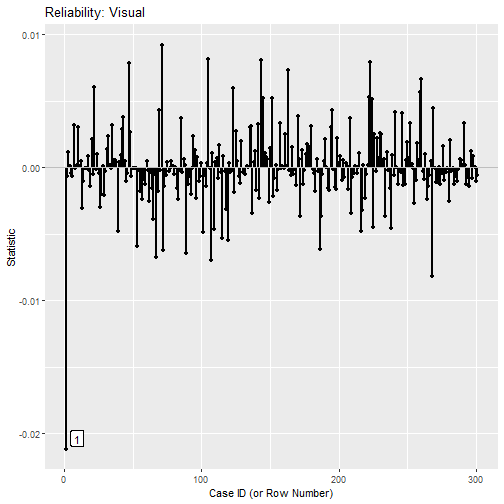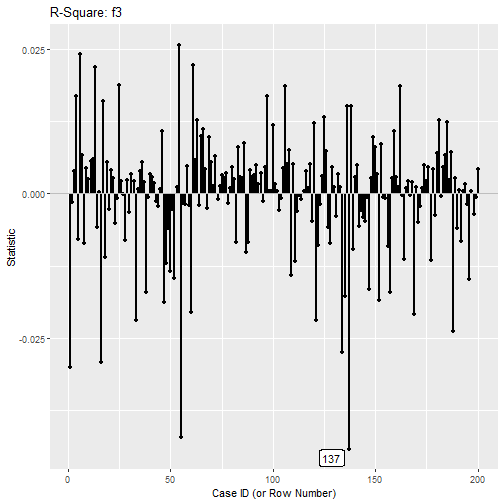
Sensitivity Analysis: Arbitrary User Function
2025-03-01
Source:vignettes/articles/user_function.Rmd
user_function.RmdGoal
This article illustrates how to identify cases that are influential
on an arbitrary statistics computed by any function, using the semfindr
package .
Readers are assumed to have a basic understanding on how to use
lavaan_rerun(), as illustrated in this
article.
Case Influence on Any Statistic
The function user_change_raw() can be use to compute
case influence measure for any statistics as long as it is provided a
function that:
accepts a
lavaanobject (e.g., the output oflavaan::cfa()orlavaan::sem()).returns a numeric vector of the statistics. If named, the names will be used. If not, names will be created automatically.
Different scenarios will be illustrated below.
Case 1: Reliability
We first illustrate computing case influence on reliability.
The sample dataset HolzingerSwineford1939 from the
lavaan package will be used for illustration.
library(semfindr)
library(lavaan)
#> This is lavaan 0.6-19
#> lavaan is FREE software! Please report any bugs.
head(HolzingerSwineford1939)
#> id sex ageyr agemo school grade x1 x2 x3 x4 x5 x6
#> 1 1 1 13 1 Pasteur 7 3.333333 7.75 0.375 2.333333 5.75 1.2857143
#> 2 2 2 13 7 Pasteur 7 5.333333 5.25 2.125 1.666667 3.00 1.2857143
#> 3 3 2 13 1 Pasteur 7 4.500000 5.25 1.875 1.000000 1.75 0.4285714
#> 4 4 1 13 2 Pasteur 7 5.333333 7.75 3.000 2.666667 4.50 2.4285714
#> 5 5 2 12 2 Pasteur 7 4.833333 4.75 0.875 2.666667 4.00 2.5714286
#> 6 6 2 14 1 Pasteur 7 5.333333 5.00 2.250 1.000000 3.00 0.8571429
#> x7 x8 x9
#> 1 3.391304 5.75 6.361111
#> 2 3.782609 6.25 7.916667
#> 3 3.260870 3.90 4.416667
#> 4 3.000000 5.30 4.861111
#> 5 3.695652 6.30 5.916667
#> 6 4.347826 6.65 7.500000For illustration, we add an influential case:
dat <- HolzingerSwineford1939
dat[1, c("x1", "x2", "x3")] <- dat[1, c("x1", "x2", "x3")] +
c(-3, +3, 0)A confirmatory factor analysis model is to be fitted to the items
x1 to x9:
mod <-
"
visual =~ x1 + x2 + x3
textual =~ x4 + x5 + x6
speed =~ x7 + x8 + x9
"
fit <- cfa(model = mod,
data = dat)Leave-One-Out (LOO) Results
We first do LOO analysis, fitting the model n times, n being the number of cases, each time with one case removed:
fit_rerun <- lavaan_rerun(fit)
#> The expected CPU time is 27.09 second(s).
#> Could be faster if run in parallel.Reliability
Suppose we are interested in the reliability of the three factors.
They can be computed by compRelSEM() from
semTools:
library(semTools)
#>
#> ###############################################################################
#> This is semTools 0.5-6
#> All users of R (or SEM) are invited to submit functions or ideas for functions.
#> ###############################################################################
fit_rel <- compRelSEM(fit)
fit_rel
#> visual textual speed
#> 0.594 0.885 0.688We can compute the influence of each case using
user_change_raw():
influence_rel <- user_change_raw(fit_rerun,
user_function = compRelSEM)The first argument is the output of lavaan_rerun().
The argument user_function is the argument used to
compute the statistics.
No other arguments are needed in this case because
compRelSEM() expects the lavaan object as the
first argument.
The output is an est_change object:
influence_rel
#>
#> -- Case Influence on User Function --
#>
#> id visual id textual id speed
#> 1 1 -0.021 262 -0.003 140 0.011
#> 2 71 0.009 113 -0.002 194 0.010
#> 3 268 -0.008 267 0.002 209 0.008
#> 4 105 0.008 1 -0.002 240 0.008
#> 5 143 0.008 53 0.002 78 -0.007
#> 6 223 0.008 194 0.002 152 0.007
#> 7 47 0.008 254 -0.002 205 0.007
#> 8 163 0.007 217 0.002 192 -0.007
#> 9 107 -0.007 252 0.002 69 -0.006
#> 10 67 -0.007 105 -0.002 34 -0.006
#>
#> Note:
#> - Changes are raw changes if a case is included.
#> - Only the first 10 case(s) is/are displayed. Set 'first' to NULL to display all cases.
#> - Cases sorted by the absolute changes for each variable.The influence is computed by:
- (User statistic with all case) - (User statistic without this case).
Therefore, if the value is positive for a case, the statistic, reliability in this case, is larger if this case is included.
Conversely, if the value is negative for a case, the statistic is decreases if this case is included.
The function index_plot() can be used to visualize the
influence. For example, this is the plot of case influence on the
reliability of visual.

The output is a ggplot object, column needs
to be set to the name of the statistic to be plotted. Refer to the help
page of index_plot() for other arguments available.
As shown by both the printout and the plot, including the first case
reduces the reliability of visual by 0.021.
We can verify this by fitting the model and compute the reliability without the first case:
fit_no_1 <- cfa(model = mod,
data = dat[-1, ])
fit_rel_no_1 <- compRelSEM(fit_no_1)
# Without the first case
fit_rel_no_1
#> visual textual speed
#> 0.615 0.887 0.685
# Including the first case
fit_rel
#> visual textual speed
#> 0.594 0.885 0.688Case 2: R-Squares
Suppose we use the compute case influence on R-squares. This is the
sample dataset, sem_dat, comes with
semfindr:
head(sem_dat)
#> x1 x2 x3 x5 x4 x6
#> 1 -3.2135320 -0.09911249 -0.4745297 -2.8185015 -2.3237313 -0.12266637
#> 2 -0.1088671 -0.03470386 -2.2979899 -0.8178882 -0.9265397 -0.01402581
#> 3 -1.7961567 -1.58736219 -1.9552732 0.9009897 -0.5253893 -0.08915439
#> 4 -0.2033852 -2.13104958 -1.7085362 -0.7472562 -3.9749580 0.19330125
#> 5 2.2112260 1.47880579 0.2114521 0.5049098 0.2629869 2.29991139
#> 6 -1.2585361 -1.16345650 -2.9582246 0.8640491 -1.0727813 -2.07746666
#> x7 x8 x9
#> 1 0.01778275 1.3242028 0.3511373
#> 2 1.81705005 -0.3905953 -0.5412106
#> 3 1.40417325 -0.3905477 -1.6177656
#> 4 -0.45070746 -2.3402317 -0.3714296
#> 5 -0.73314813 -0.1867083 0.4762137
#> 6 0.02449975 -0.2139832 -3.4676929
mod <-
"
f1 =~ x1 + x2 + x3
f2 =~ x4 + x5 + x6
f3 =~ x7 + x8 + x9
f2 ~ f1
f3 ~ f2 + f1
"
fit <- sem(mod,
data = sem_dat)The R-squares can be retrieved in different ways. For example, it can
be extracted by lavInspect() from lavaan:
lavInspect(fit, what = "rsquare")
#> x1 x2 x3 x4 x5 x6 x7 x8 x9 f2 f3
#> 0.330 0.166 0.324 0.675 0.425 0.187 0.102 0.315 0.486 0.463 0.596Let’s do LOO first:
fit_rerun <- lavaan_rerun(fit)
#> The expected CPU time is 9 second(s).
#> Could be faster if run in parallel.We then call user_change_raw() to compute case
influence:
influence_rsq <- user_change_raw(fit_rerun,
user_function = lavInspect,
what = "rsquare")This example illustrates an advanced scenario. The function
lavInspect() requires one more argument, what,
to know that we want the R-squares. Such arguments require by
user_function can be passed directly to
user_change_raw(), which will pass them to
user_function.
This is the output:
influence_rsq
#>
#> -- Case Influence on User Function --
#>
#> id x1 id x2 id x3 id x4 id x5 id x6 id x7
#> 1 88 -0.029 100 -0.018 112 -0.028 46 -0.045 46 0.031 61 0.016 46 0.019
#> 2 61 -0.022 125 0.017 147 -0.028 61 0.028 6 -0.022 46 0.015 27 -0.012
#> 3 120 -0.019 109 -0.014 91 -0.021 99 -0.027 178 0.019 25 0.014 110 0.012
#> 4 110 0.019 96 -0.014 61 0.020 24 -0.026 137 0.019 128 -0.014 18 0.011
#> 5 21 -0.018 149 0.013 84 -0.020 178 -0.023 110 0.018 108 -0.014 30 -0.011
#> 6 180 -0.018 75 -0.012 126 -0.017 25 0.022 25 -0.018 149 -0.013 179 0.009
#> 7 162 -0.016 116 -0.011 110 0.016 87 -0.020 200 -0.017 175 -0.013 14 -0.009
#> 8 187 -0.014 179 -0.011 46 0.015 110 -0.018 149 -0.015 164 0.012 25 0.009
#> 9 46 0.013 4 0.010 13 0.015 197 -0.018 176 -0.015 60 -0.012 3 -0.009
#> 10 59 0.012 63 0.010 6 0.014 6 0.017 70 -0.014 178 0.011 19 -0.009
#> id x8 id x9 id f2 id f3
#> 1 106 -0.027 54 -0.030 55 -0.029 137 -0.044
#> 2 125 0.023 162 -0.027 162 -0.029 55 -0.042
#> 3 59 -0.017 134 -0.026 46 0.028 1 -0.030
#> 4 75 -0.017 66 -0.024 35 -0.027 16 -0.029
#> 5 172 -0.017 97 -0.023 149 -0.026 134 -0.027
#> 6 17 0.015 14 -0.022 119 -0.025 54 0.026
#> 7 63 0.015 46 0.022 178 0.022 6 0.024
#> 8 179 0.014 136 -0.021 3 -0.022 188 -0.024
#> 9 61 0.013 63 0.021 49 -0.021 61 0.022
#> 10 25 0.013 25 -0.018 137 0.021 121 -0.022
#>
#> Note:
#> - Changes are raw changes if a case is included.
#> - Only the first 10 case(s) is/are displayed. Set 'first' to NULL to display all cases.
#> - Cases sorted by the absolute changes for each variable.We can use index_plot() again. Let’s plot case influence
on the R-square of f3:

The 137th case, if included, decreases the R-square of
f3 by about 0.044, as shown in both the printout and the
index plot.
Final Remarks
The function user_change_raw() can also be used for
function for which the lavaan-class object is not the first
argument. Please refer to the help page of
user_change_raw() on how to set this argument.